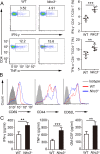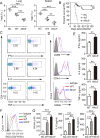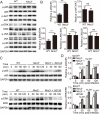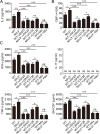NLRC3 negatively regulates CD4+ T cells and impacts protective immunity during Mycobacterium tuberculosis infection
- PMID: 30133544
- PMCID: PMC6122840
- DOI: 10.1371/journal.ppat.1007266
NLRC3 negatively regulates CD4+ T cells and impacts protective immunity during Mycobacterium tuberculosis infection
Abstract
NLRC3, a member of the NLR family, has been reported as a negative regulator of inflammatory signaling pathways in innate immune cells. However, the direct role of NLRC3 in modulation of CD4+ T-cell responses in infectious diseases has not been studied. In the present study, we showed that NLRC3 plays an intrinsic role by suppressing the CD4+ T cell phenotype in lung and spleen, including differentiation, activation, and proliferation. NLRC3 deficiency in CD4+ T cells enhanced the protective immune response against Mycobacterium tuberculosis infection. Finally, we demonstrated that NLRC3 deficiency promoted the activation, proliferation, and cytokine production of CD4+ T cells via negatively regulating the NF-κB and MEK-ERK signaling pathways. This study reveals a critical role of NLRC3 as a direct regulator of the adaptive immune response and its protective effects on immunity during M. tuberculosis infection. Our findings also suggested that NLRC3 serves as a potential target for therapeutic intervention against tuberculosis.
Conflict of interest statement
The authors have declared that no competing interests exist.
Figures







Similar articles
-
Negative regulator NLRC3: Its potential role and regulatory mechanism in immune response and immune-related diseases.Front Immunol. 2022 Oct 20;13:1012459. doi: 10.3389/fimmu.2022.1012459. eCollection 2022. Front Immunol. 2022. PMID: 36341336 Free PMC article. Review.
-
The Innate Immune Sensor NLRC3 Acts as a Rheostat that Fine-Tunes T Cell Responses in Infection and Autoimmunity.Immunity. 2018 Dec 18;49(6):1049-1061.e6. doi: 10.1016/j.immuni.2018.10.008. Immunity. 2018. PMID: 30566882 Free PMC article.
-
NLRC3 expression in dendritic cells attenuates CD4+ T cell response and autoimmunity.EMBO J. 2019 Aug 15;38(16):e101397. doi: 10.15252/embj.2018101397. Epub 2019 Jul 10. EMBO J. 2019. PMID: 31290162 Free PMC article.
-
Interleukin 27R regulates CD4+ T cell phenotype and impacts protective immunity during Mycobacterium tuberculosis infection.J Exp Med. 2015 Aug 24;212(9):1449-63. doi: 10.1084/jem.20141520. Epub 2015 Aug 17. J Exp Med. 2015. PMID: 26282876 Free PMC article. Clinical Trial.
-
Overview of the anti-inflammatory function of the innate immune sensor NLRC3.Mol Immunol. 2023 Jan;153:36-41. doi: 10.1016/j.molimm.2022.11.014. Epub 2022 Nov 17. Mol Immunol. 2023. PMID: 36403432 Review.
Cited by
-
The NLRP3 inflammasome: a new player in neurological diseases.Turk J Biol. 2019 Dec 13;43(6):349-359. doi: 10.3906/biy-1909-31. eCollection 2019. Turk J Biol. 2019. PMID: 31892810 Free PMC article.
-
Role of NLRC3 in modulating inflammatory responses in neonates.BMC Pediatr. 2025 May 28;25(1):428. doi: 10.1186/s12887-025-05766-7. BMC Pediatr. 2025. PMID: 40437402 Free PMC article.
-
NLRC3 attenuates osteoclastogenesis by limiting TNFα+ Th17 cell response in osteoporosis.J Mol Med (Berl). 2024 May;102(5):655-665. doi: 10.1007/s00109-024-02422-y. Epub 2024 Mar 4. J Mol Med (Berl). 2024. PMID: 38436712 Free PMC article.
-
Nuclear receptor subfamily 4 group a member 1 eases angiotensin II-arose oxidative stress in vascular smooth muscle cell by boosting nucleotide-binding oligomerization domain-like receptor family caspase recruitment domain containing 3 transcription.Cytojournal. 2024 Nov 16;21:43. doi: 10.25259/Cytojournal_86_2024. eCollection 2024. Cytojournal. 2024. PMID: 39737121 Free PMC article.
-
Negative regulator NLRC3: Its potential role and regulatory mechanism in immune response and immune-related diseases.Front Immunol. 2022 Oct 20;13:1012459. doi: 10.3389/fimmu.2022.1012459. eCollection 2022. Front Immunol. 2022. PMID: 36341336 Free PMC article. Review.
References
Publication types
MeSH terms
Substances
LinkOut - more resources
Full Text Sources
Other Literature Sources
Medical
Molecular Biology Databases
Research Materials
Miscellaneous

